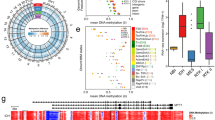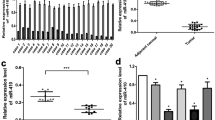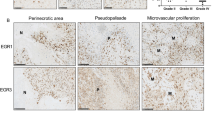Abstract
The SLIT family of genes consists of large extracellular matrix-secreted and membrane-associated glycoproteins. The Slits (Slit1–3) are ligands for the repulsive guidance receptors, the robo gene family. The Slit–Robo interactions mediate the repulsive cues on axons and growth cones during neural development. In a recent report, we demonstrated that promoter region CpG island of human SLIT2 was frequently hypermethylated in lung, breast and colorectal tumours and the silenced gene transcript suppressed the malignant phenotype in in vitro assays. In this report we undertook epigenetic, genetic and expression analysis of SLIT2 gene in a large series of gliomas and glioma cell lines. Promoter region CpG island of SLIT2 was found to be methylated in 71% (5/7) of glioma cell lines and was unmethylated in five DNA samples from normal brain tissues. The hypermethylation of the SLIT2 promoter region in glioma cell lines correlated with loss of expression and treatment with the demethylating agent 5-aza-2’-deoxycytidine reactivated SLIT2 gene expression. In primary gliomas, SLIT2 was methylated in 59% (37/63) of tumours analysed. In addition, SLIT2 expression was downregulated in methylated gliomas relative to unmethylated tumour samples, as demonstrated by quantitative real-time RT–PCR. Loss of heterozygosity analysis revealed that SLIT2 methylated gliomas retained both alleles of a microsatellite marker within 100 kb of the SLIT2 gene at 4p15.2. Exogenous expression of SLIT2 in a glioma cell line that was heavily methylated for SLIT2 decreased in vitro colony formation. Our data indicate that SLIT2 is frequently inactivated by promoter region CpG island hypermethylation in gliomas and may be a good candidate for a glioma tumour suppressor gene (TSG) located at 4p15.2. Furthermore, our data suggest that a detailed analysis of both the cancer genome and epigenome will be required to identify key TSGs involved in glioma development.
This is a preview of subscription content, access via your institution
Access options
Subscribe to this journal
Receive 50 print issues and online access
$259.00 per year
only $5.18 per issue
Buy this article
- Purchase on Springer Link
- Instant access to full article PDF
Prices may be subject to local taxes which are calculated during checkout




Similar content being viewed by others
References
Agathanggelou A, Honorio S, Macartney DP, Martinez A, Dallol A, Rader J, Fullwood P, Chauhan A, Walker R, Shaw JA, Hosoe S, Lerman MI, Minna JD, Maher ER and Latif F . (2001). Oncogene, 20, 1509–1518.
Astuti D, Agathanggelou A, Honorio S, Dallol A, Martinsson T, Kogner P, Cummins C, Neumann HPH, Voutilainen R, Dahia P, Eng C, Maher ER and Latif F . (2001). Oncogene, 20, 7573–7577.
Brose K, Bland KS, Wang KH, Arnott D, Henzel W, Goodman CS, Tessier-Lavigne M and Kidd T . (1999). Cell, 96, 795–806.
Burbee DG, Forgacs E, Zöchbauer-Müller S, Shivakumar L, Gao B, Randle D, Virmani A, Bader S, Sekido Y, Latif F, Fong K, Gazdar AF, Lerman MI, White M and Minna JD . (2001). J. Natl. Cancer Inst., 93, 691–699.
Burton EC, Lamborn KR, Feuerstein BG, Prados M, Scott J, Forsyth P, Passe S, Jenkins RB and Aldape KD . (2002). Cancer Res., 62, 6205–6210.
Costello JF and Plass C . (2001). J. Med. Genet., 38, 285–303.
Dallol A, Da Silva NF, Viacava P, Minna JD, Maher ER and Latif F . (2002a). Cancer Res., 62, 5874–5880.
Dallol A, Forgacs E, Martinez A, Sekido Y, Walker R, Kishida T, Rabbitts P, Maher ER and Latif F . (2002b). Oncogene, 21, 3020–3028.
Dallol A, Morton D, Maher ER and Latif F . (2003). Cancer Res., 63, 1054–1058.
Dammann R, Li C, Yoon JH, Chin PL, Bates S and Pfeifer GP . (2000). Nat. Genet., 25, 315–319.
Dammann R, Yang G and Pfeifer GP . (2001). Cancer Res., 61, 3105–3109.
Dreijerink K, Braga E, Kuzmin I, Geil L, Duh FM, Angeloni D, Zbar B, Lerman MI, Stanbridge EJ, Minna JD, Protopopov A, Li JF, Kashuba V, Klein G and Zabarovsky ER . (2001). Proc. Natl. Acad. Sci. USA, 98, 7504–7509.
Greger V, Debus N, Lohmann D, Hopping W, Passarge E and Horsthemke B . (1994). Hum. Genet., 94, 491–496.
Herman JG, Graff JR, Myohanen S, Nelkin BD and Baylin SB . (1996). Proc. Natl. Acad. Sci. USA, 93, 9821–9826.
Herman JG, Latif F, Weng Y, Lerman MI, Zbar B, Liu S, Samid D, Duan DS, Gnarra JR and Linehan WM . (1994). Proc. Natl. Acad. Sci. USA, 91, 9700–9704.
Holland EC . (2001). Nat. Rev. Genet., 2, 120–129.
Jones PA . (1999). Trends Genet., 15, 34–37.
Jones PA and Baylin SB . (2002). Nat. Rev. Genet., 3, 415–428.
Lo KW, Kwong J, Hui ABY, Chan SYY, To KF, Chan SC, Chow LSN, Teo PML, Johnson PJ and Huang DP . (2001). Cancer Res., 61, 3877–3881.
Louis DN, Pomeroy SL and Cairncross JG . (2002). Cancer Cell, 1, 125–128.
Lusher ME, Lindsey JC, Latif F, Pearson AD, Ellison DW and Clifford SC . (2002). Cancer Res., 62, 5906–5911.
Morrissey C, Martinez A, Zatyka M, Agathanggelou A, Honorio S, Astuti D, Morgan NV, Moch H, Richards FM, Kishida T, Yao M, Schraml P, Latif F and Maher ER . (2001). Cancer Res., 61, 7277–7281.
Rajagopalan S, Vivancos V, Nicolas E and Dickson BJ . (2000). Cell, 103, 1033–1045.
Simpson JH, Bland KS, Fetter RD and Goodman CS . (2000). Cell, 103, 1019–1032.
Stein E and Tessier-Lavigne M . (2001). Science, 291, 1928–1938.
Wong K, Ren XR, Huang YZ, Xie Y, Liu G, Saito H, Tang H, Wen L, Brady-Kalnay SM, Mei L, Wu JY, Xiong WC and Rao Y . (2001). Cell, 107, 209–221.
Xian J, Clark KJ, Fordham R, Pannell R, Rabbitts TH and Rabbitts PH . (2001). Proc. Natl. Acad. Sci. USA, 98, 15062–15066.
Yin D, Dong X, Hofmann WK, Miller CW, Black KL and Koeffler HP . (2002). Oncogene, 21, 8372–8378.
Acknowledgements
This work was in part supported by Cancer Research UK. We thank Uta Neumeister for her thorough technical assistance.
Author information
Authors and Affiliations
Corresponding author
Rights and permissions
About this article
Cite this article
Dallol, A., Krex, D., Hesson, L. et al. Frequent epigenetic inactivation of the SLIT2 gene in gliomas. Oncogene 22, 4611–4616 (2003). https://doi.org/10.1038/sj.onc.1206687
Received:
Revised:
Accepted:
Published:
Issue Date:
DOI: https://doi.org/10.1038/sj.onc.1206687
Keywords
This article is cited by
-
The Therapeutic Role of Slit2 in Anti-fibrosis, Anti-inflammation and Anti-oxidative Stress in Rats with Coronary Heart Disease
Cardiovascular Toxicology (2021)
-
Mutation profiling in eight cases of vagal paragangliomas
BMC Medical Genomics (2020)
-
Tumoural activation of TLR3–SLIT2 axis in endothelium drives metastasis
Nature (2020)
-
Silymarin inhibited DU145 cells by activating SLIT2 protein and suppressing expression of CXCR4
Medical Oncology (2020)
-
A Traveling Wave Ion Mobility Spectrometry (TWIMS) Study of the Robo1-Heparan Sulfate Interaction
Journal of the American Society for Mass Spectrometry (2018)



